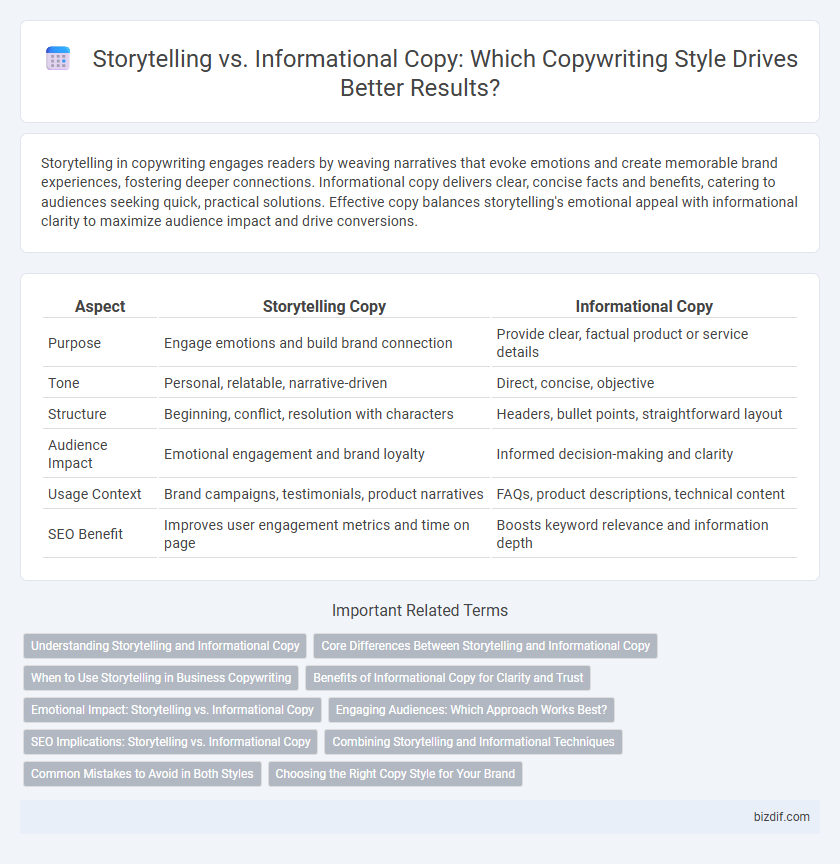Storytelling in copywriting engages readers by weaving narratives that evoke emotions and create memorable brand experiences, fostering deeper connections. Informational copy delivers clear, concise facts and benefits, catering to audiences seeking quick, practical solutions. Effective copy balances storytelling's emotional appeal with informational clarity to maximize audience impact and drive conversions.
Table of Comparison
| Aspect | Storytelling Copy | Informational Copy |
|---|---|---|
| Purpose | Engage emotions and build brand connection | Provide clear, factual product or service details |
| Tone | Personal, relatable, narrative-driven | Direct, concise, objective |
| Structure | Beginning, conflict, resolution with characters | Headers, bullet points, straightforward layout |
| Audience Impact | Emotional engagement and brand loyalty | Informed decision-making and clarity |
| Usage Context | Brand campaigns, testimonials, product narratives | FAQs, product descriptions, technical content |
| SEO Benefit | Improves user engagement metrics and time on page | Boosts keyword relevance and information depth |
Understanding Storytelling and Informational Copy
Storytelling copy engages readers by weaving narratives that evoke emotions and create memorable brand connections, making complex ideas relatable through characters and plot. Informational copy delivers clear, concise facts and benefits focused on educating the audience or driving decision-making with logical persuasion. Understanding the balance between storytelling's emotional appeal and informational copy's clarity is crucial for crafting effective marketing messages that resonate and convert.
Core Differences Between Storytelling and Informational Copy
Storytelling copy engages audiences through emotional narratives and relatable characters, creating a memorable brand experience that fosters connection and loyalty. Informational copy prioritizes clarity and facts, delivering precise details and benefits to guide decision-making and prompt action. The core difference lies in storytelling's focus on emotional resonance versus informational copy's emphasis on straightforward communication and utility.
When to Use Storytelling in Business Copywriting
Storytelling in business copywriting is most effective when aiming to create an emotional connection with the audience, build brand identity, and increase customer engagement. It works well for campaigns targeting brand loyalty, product launches, or complex solutions that benefit from relatable narratives. Use storytelling to make abstract benefits tangible and memorable, enhancing persuasion beyond straightforward informational copy.
Benefits of Informational Copy for Clarity and Trust
Informational copy enhances clarity by presenting factual, straightforward content that helps readers quickly understand product features and benefits. This transparent communication builds trust with the audience by demonstrating expertise and reliability without relying on emotional appeal. Clear informational copy reduces ambiguity, making purchasing decisions easier and fostering long-term customer confidence.
Emotional Impact: Storytelling vs. Informational Copy
Storytelling copy leverages emotional narratives to create a strong connection with the audience, enhancing brand loyalty and engagement. Informational copy prioritizes clarity and facts, effectively delivering product features and benefits but often lacking emotional resonance. Brands that integrate storytelling techniques typically experience higher conversion rates by emotionally engaging their customers.
Engaging Audiences: Which Approach Works Best?
Storytelling copy captivates audiences by creating emotional connections through relatable narratives, making brands memorable and fostering loyalty. Informational copy delivers clear, concise facts that satisfy immediate needs, appealing to consumers seeking straightforward solutions. Combining storytelling's engagement with informational copy's clarity often yields the most effective approach for diverse audience preferences.
SEO Implications: Storytelling vs. Informational Copy
Storytelling copy leverages emotional engagement and narrative structure to enhance user experience and increase dwell time, positively impacting SEO rankings by reducing bounce rates. Informational copy focuses on delivering clear, keyword-rich content optimized for search intent, improving keyword relevance and indexing by search engines. Combining storytelling elements with well-researched keywords creates a balanced SEO strategy that drives both engagement and organic traffic growth.
Combining Storytelling and Informational Techniques
Combining storytelling and informational copy enhances audience engagement by weaving compelling narratives with clear, data-driven insights. This approach creates emotional connections while delivering valuable knowledge, improving retention and conversion rates. Marketers utilizing both techniques achieve more persuasive content by blending relatable stories with factual information.
Common Mistakes to Avoid in Both Styles
Common mistakes in storytelling copy include overloading the narrative with irrelevant details and failing to create emotional connections that engage readers. Informational copy often suffers from excessive jargon and lack of clear, concise messaging, which can overwhelm or confuse the audience. Both styles benefit from a strong focus on audience needs, clear value propositions, and maintaining a balanced, reader-centric tone for maximum impact.
Choosing the Right Copy Style for Your Brand
Storytelling copy engages audiences through emotional narratives, building brand identity and loyalty by connecting on a personal level. Informational copy delivers clear, concise facts and benefits, ideal for educating customers and driving conversion with straightforward messaging. Selecting the right copy style depends on your brand's goals, target audience preferences, and desired engagement strategy to optimize communication effectiveness.
Storytelling vs Informational Copy Infographic

 bizdif.com
bizdif.com